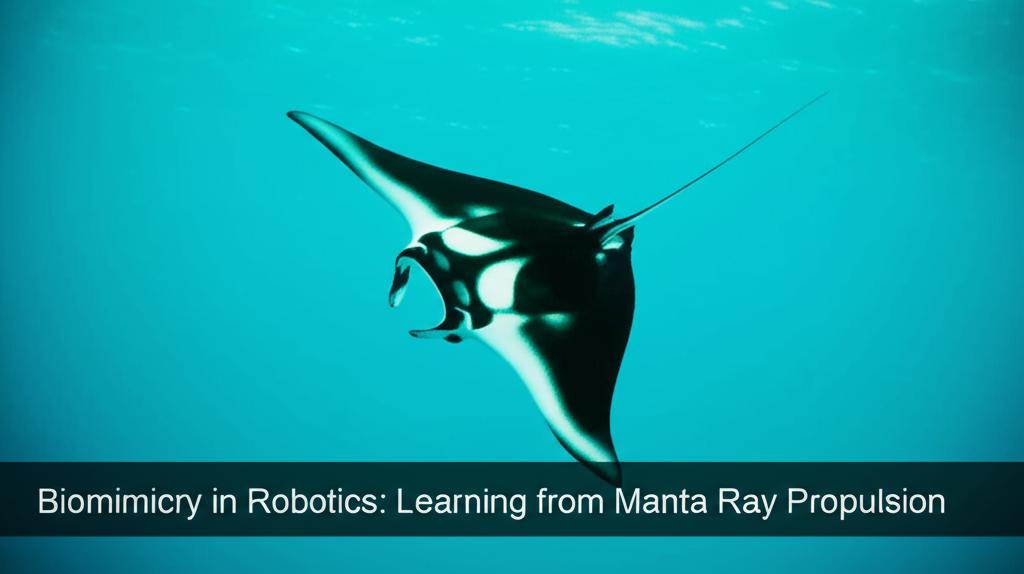Manta rays, with their highly efficient and agile swimming capabilities, have become a significant source of inspiration for the development of next-generation underwater robots. Researchers are actively exploring how the unique propulsion methods of these cartilaginous fish can be translated into robotic systems, aiming to create autonomous underwater vehicles (AUVs) that are more maneuverable, stable, and energy-efficient than their traditional propeller-driven counterparts.
Key Advantages of Manta Ray-Inspired Propulsion:- Enhanced Maneuverability and Stability: Manta rays achieve outstanding stability and maneuverability, particularly at low speeds, by using their large pectoral fins for propulsion. This "median and/or paired fin (MPF)" mode allows for agile movements and resistance to disturbances, making them ideal for tasks requiring precise positioning and navigation in complex underwater environments.
- Energy Efficiency: The gliding and flapping motions of manta rays are inherently efficient. Roboticists aim to replicate this to create AUVs with longer operational times and ranges.
- Reduced Environmental Disturbance: Unlike propeller-driven systems that can be noisy and disruptive to marine ecosystems, the gentle, flapping motion of manta-inspired robots minimizes noise emissions and water disturbance. This makes them suitable for delicate tasks like ecological surveys and marine life observation.
- Versatility: The ability to carry various sensors and tools, coupled with agile movement, makes these robots suitable for a wide range of applications, including seabed mapping, infrastructure inspection and repair, and even aquaculture monitoring.
- Improved Speed and Efficiency: Researchers at North Carolina State University have developed a soft robot inspired by manta rays that has set a new speed record for swimming soft robots, reaching 6.8 body lengths per second. This is nearly double the speed of their previous model and was achieved with greater energy efficiency. The design uses a single-actuation mechanism powered by compressed air to mimic the manta's fin strokes, allowing for rapid movement and versatility in navigating complex vertical environments.
- Deep-Sea Exploration: A team at Westlake University in China successfully tested their "Sea Guru II" manta ray-inspired robot in a 2,000-meter deep-sea trial in the South China Sea in March 2025. This 3-meter long and wide robot demonstrated complex movements and operations near the seafloor. The design focuses on mimicking the manta's fluid silhouette to address buoyancy and stability issues often faced by humanoid underwater robots. Key innovations include fully flexible undulating fins for improved propulsive efficiency and directional control, and a "belly pod" to carry various tools, including robotic arms and miniature drone submarines.
- Bio-Syncretic Robotics: Scientists at the Shenyang Institute of Automation, Chinese Academy of Sciences, have developed a bionic swimming robot actuated by cultured skeletal muscle tissue. This "bio-syncretic" robot, inspired by the manta ray's structure, can be efficiently propelled by a single muscle tissue and controlled using a novel dynamic control method based on circular distributed multiple electrodes (CDME). This research explores the fusion of biological materials with robotic systems for actuation and control.
- Understanding Collective Motion: Researchers at Northwestern Polytechnical University and the Ningbo Institute of NPU in China have modeled the group dynamics of manta rays to understand how their formations affect propulsion. They found that certain formations, like a tandem line, can increase propulsion for the middle individual, while other triangular formations might decrease overall efficiency compared to a single swimmer. These findings can help optimize formations for multi-vehicle underwater operations.
- Material and Structural Innovations: Many designs incorporate a rigid-flexible coupling, where passive deformation of soft, flexible fins generates effective propulsion. This allows robots to replicate the complex fin movements of real manta rays while maintaining a lightweight and flexible structure. Materials like polydimethylsiloxane (PDMS) are often used for the main body and fins. Some designs utilize multi-rigid link pectoral fins to actively reproduce and uniquely define bending movements, offering an alternative to purely soft, passively controlled fins.
- Enhanced Control and Autonomy: Robotic manta rays are often equipped with a variety of sensors to perceive their underwater state. Researchers are integrating depth and direction control algorithms, sometimes using fuzzy controllers, to enhance the autonomy and flexibility of these robots in complex underwater environments. This includes capabilities for autonomous obstacle navigation, real-time monitoring, and adaptive adjustments to altitude, depth, and orientation. Some robots have demonstrated the ability to locate and approach targets, such as sea cucumbers in aquaculture settings.
- Addressing Limitations of Traditional ROVs: In environments with significant debris or floating objects, traditional propeller-driven remotely operated vehicles (ROVs) can face jamming issues. Manta ray-inspired designs, with their mobuliform movement, offer a potential solution for more agile and maneuverable ROVs in such constrained scenarios.
The field of manta ray-inspired robotics continues to evolve. Future research will likely focus on:
- Further improving energy efficiency and speed.
- Developing more sophisticated autonomous control systems, potentially incorporating AI and deep learning for enhanced perception and decision-making.
- Miniaturization for applications like in-vivo drug delivery.
- Enhancing the payload capacity and the integration of more complex sensor suites and tools.
- Refining the bio-mimicry to more accurately replicate the nuanced hydrodynamics of manta ray propulsion for even greater performance.
- Exploring advanced actuation methods, including further development of bio-hybrid systems and smart materials like Shape Memory Alloys (SMA) and dielectric elastomer actuators (DEAs).
By continuing to learn from the elegant and efficient propulsion of manta rays, engineers and scientists are poised to create a new generation of underwater robots capable of exploring and interacting with the marine world in unprecedented ways.

